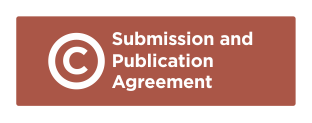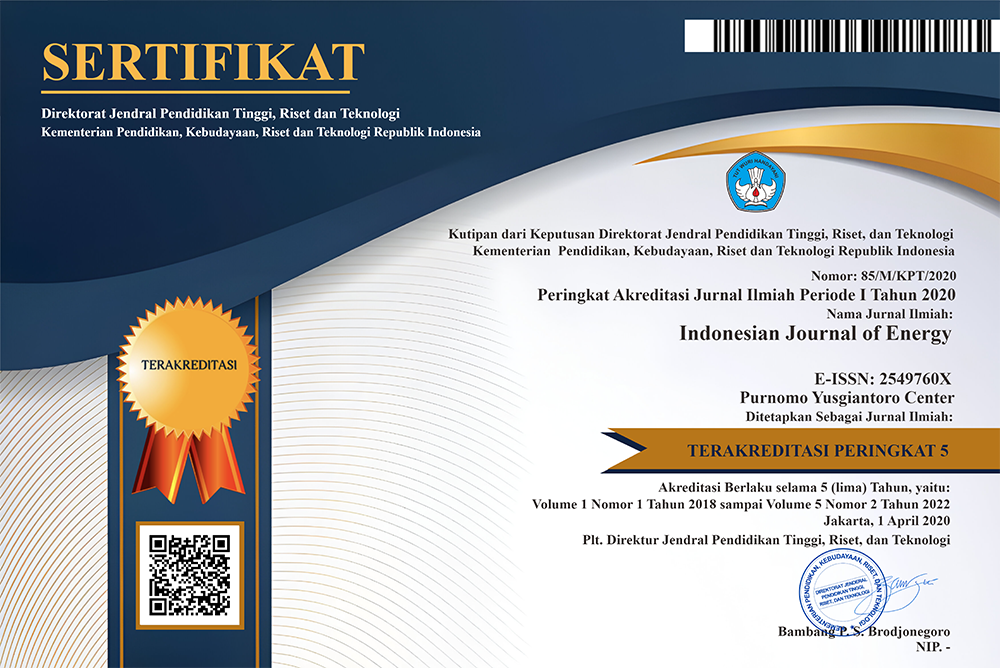Striving for Energy Security
South Korea's Internal and External Energy Policy After the Fukushima Tragedy
Abstract
This paper analyzes South Korea's energy policy after the Fukushima disaster. The policy is seen from two dimensions, namely internal policies and external policies. The variable used in viewing the policy is through the framework described by Duffield. According to Duffield, internal policy responses can be seen from emergency preparations and reducing dependencies on foreign energy sources. In contrast, external policy response can be seen through policy toward energy-producing and transit countries, also other energy-consuming and importing countries. This research is qualitative with descriptive analytics. The study found that South Korea took several energy policies related to its domestic politics to reduce its dependence on energy imports. At the same time, for the external responses, South Korea intends to diversify its cooperation with the energy-exporting countries and continues to encourage international cooperation among the importing countries.
Downloads
References
Abe, S., & Thangavelu, S. M. (2012). Natural disasters and asia: Introduction. Asian Economic Journal, 26(3), 181–187.
ASEAN Centre for Energy (2021). ASEAN-Korea capacity building workshop on energy efficiency and conservation (EE & C) for industry and transportation sector. https://aseanenergy.org/asean-korea-capacity-building-workshop-on-energy-efficiency-and-conservation-eec-for-industry-and-transportation-sector/
Azhar, M., & Satriawan, D. A. (2018). Implementasi kebijakan energi baru dan energi terbarukan dalam rangka ketahanan energi nasional. Adminitrative Law & Governance Journal, (1).
Boo, K. (2016). Republic of Korea country report. In S. Kimura & P. Han, (eds), Energy outlook and energy saving potential in East Asia 2016. (pp. 177–192).
Cahyani, D. D. (2017). Kepentingan Korea Selatan dalam kerjasama investasi minyak dengan Iran. Universitas Jember.
Chang, Y. H. (2006). Energy and security: The geopolitics of energy in the Asia-Pacific. Nanyang Technological University.
Chen, W. M., Kim, H., & Yamaguchi, H. (2014). Renewable energy in Eastern Asia: Renewable energy policy review and comparative SWOT analysis for promoting renewable energy in Japan, South Korea, and Taiwan. Energy Policy.
Choi, H. T., & Kim, T. R. (2018). Necessity of management for minor earthquake to improve public acceptance of nuclear energy in South Korea. Nuclear Enginerering and Technology.
Chong, X. Y. (2011). Nuclear energy development in Asia: Problems and prospects. Palgrave Macmillan.
Chung, J. B., & Kim, E. S. (2018). Public perception of energy transition in Korea: Nuclear power climate change and party preference. Energy Policy Journal, 116, 137–144.
Chung, W. S., Kim, S. S., Moon, K. H., Lim, C. Y., & Yun, S. W. (2017). A conceptual framework For energy security evaluation of power sources in South Korea. Energy Journal, 137, 1066–1074
Compendium of Energy Efficiency Policies in APEC Economies. (2017). Energy efficiency in Korea: Government supported research & development.
Creswell, J. W. (2003). Research design: Qualitative, quantitative and mixed methods approaches (2nd ed). SAGE Publications.
Dongli, S. (2011). Nuclear energy development in China. In X. Y. Chong (Eds), Nuclear energy development in Asia: Problems and prospects. Palgrave Macmillan.
Doukas, H., Patlitzianas, K., & Kagiannas, A. (2008). Energy policy making: An old concept or a modern challenge? Taylor & Francis Group, 362–371.
Duffield, J. S. (2015). Seeking energy security in Europe, Japan, and the United State. John Hopkins University Press.
European Union. (2021). South Korea’s pledge to achieve carbon neutrality by 2050. European Parliament.
Geels, F.W. (2002). Technological transitions as evolutionary reconfiguration Process: A multi-level perspective and case study. Research Policy, 31(8/9), 1257–1274.
Hae, W. J. (2022). South Korea’s middle power diplomacy in the Middle East: Development, political and diplomatic trajectories. Routledge Taylor & Francis Group.
Hong, S. (2011). Where is the nuclear nation going? Hopes and fears over nuclear energy in South Korea after the Fukushima Disaster. International Journal, 409–416.
Hugo, I. (2020). Jepang dan geopolitik energi kontemporer: Memahami strategi keamanan energi Jepang pasca bencana Fukushima. Universitas Pertamina.
International Energy Agency. (2020). Energy policy review Korea 2020. IEA Report.
International Energy Agency Join Report with KEEi. (2021). Korea electricity security review: A join report with the Korea Energy Economics Institute. IEA Publications.
Kedutaan Besar Republik Korea untuk RI (2019). Guide to living in Korea. Korea Trade-Investment Promotion Agency. http://overseas.mofa.go.kr/id-id/index.do
Kim, H., Shin, E. S., & Chung, W. J. (2011). Energy demand and supply, energy policies, and energy security in the Republic of Korea. Energy Policy Journal, 39, 6882–6897.
Kim, J., Park, S. Y., & Lee, J. (2018). Do people really want renewable energy? Who wants renewable energy? Discrete choice model of reference dependent preference in South Korea. Energy Policy.
Korea Energy Agency. (2015). Feed-in tariffs for new and renewable energy. https://dco.energy.or.kr/renew_eng/new/renewable.aspx
Korea Energy Agency. (2015). PV rental business. https://dco.energy.or.kr/renew_eng/new/program.aspx
Korea Energy Agency. (2015). Rational energy use in public institutions. https://dco.energy.or.kr/renew_eng/new/rationalization.aspx
Korea Energy Agency. (2015). Renewable portfolio standards (RPS). https://dco.energy.or.kr/renew_eng/new/standards.aspx
Korea Energy Agency. (2015). Soft loans for new and renewable energy. https://dco.energy.or.kr/renew_eng/new/financing.aspx
Korea Energy Agency. (2017). Overview of new and renewable energy in Korea. KEA: New & Renewable Energy Center
Korea Institute of Energy Technology Evaluation and Planning. (nd). Research and development (R&D) Programs. http://www.ketep.re.kr/contents/siteMain.do?srch_mu_lang=CDIDX00023
Korea International Renewable Energy Conference. (2019). South Korea and REN21 bringing multistakeholders to the East Asian Capital Seoul. KIREC Report.
Korea National Oil Corporations. (2011). Petroleum Stockpiling.
Lai, H. (2009). Asian energy security: The maritime dimension. Palgrave Macmillan.
Lee, M. (2011). The past, present and future of nuclear power in Taiwan. In X. Y. Chong (Eds), Nuclear energy development in Asia: Problems and prospects. Palgrave Macmillan.
Lee, T. (2020). From nuclear energy developmental state to energy transition in South Korea: The role of the political epistemic community. Environmental Policy and Governance.
Levkowiz, A. (2013). South Korea’s Middle East policy. The Begin-Sadat Center For Strategic Studies Bar-Ilan University.
Lim, E. (2019). South Korea’s nuclear dilemmas. Journal For Peace And Nuclear Disarmament, 2(1), 297–318.
Maennel, A., & Kim, H. G. (2018). Comparison of greenhouse gas reduction potential through renewable energy transition in south korea and germany. Energy Article.
Ministry of Foreign Affairs Republic of Korea. (2020). Policy information: Energy. https://mofa.go.kr/eng/wpge/m_5657/contents.do
Ministry of Trade, Industry and Energy Republic of Korea. (2020). The 9th basic plan of long-term electricity supply and demand in Korean. https://www.korea.kr/news/pressReleaseView.do?newsld=156429427&call_from=rsslink
Muyasaroh, N. N., Harini, S., & Dipokusumo. (2018). Kerjasama bilateral Indonesia-Korea Selatan dalam pengembangan penelitian sumber energi alternatif: Studi kasus kerjasama penelitian LIPI-KIST dalam memanfaatkan limbah tandan kosong kelapa sawit. Universitas Slamet Riyadi Surakarta.
Nakata, T. (2011). Nuclear energy development in Japan. In X. Y. Chong (Eds), Nuclear energy development in Asia: Problems and prospects. Palgrave Macmillan.
Narita, J & Cames, L. (2019). Promoting acceptance of wind and solar energy in Korea. Adelphi Consult GmbH
Observatory Of Economic Complexity. (2015). South Korea. http://atlas.media.mit.edu/en/profile/country/irn/
Park, J., & Kim, B. (2019). An analysis of South Korea's energy transition policy with regards to offshore wind power development. Renewable and Sustainable Energy Reviews, 109, 71–84.
Park, R. (2017). A comparative assessment of the role of energy in Qatar’s East Asian foreign relations: case studies on China, Japan, and South Korea. PQDT-Global.
Poirier, M. (2011). Towards a green Korea? Assessing South Korea’s energy security from diversification to diplomacy. Yonsei GSIS Journal of International Studies.
Roh, S., & Kim, D. (2017). Effect of Fukushima accident on public acceptance of nuclear energy (Fukushima accident and nuclear public accptance). Energy Sources.
Ryu, J. C. (2015). Korea’s green growth experince: Process, outcomes and lessons learned. Global Green Growth Institute. https://gggi.org/report/koreas-green-growth-experienceprocess-outcomes-and-lessons-learned/
Shadrina, E., & Bradshaw, M. (2013). Russia’s energy governance transitions and implications for enhanced cooperation with China, Japan, and South Korea. Post-Soviet Affairs, Routledge Taylor & Francis Group, 29(6), 461–499.
Suhaemi, T. (2017). Pengembangan pembangkit listrik tenaga nuklir di Korea Selatan: Pembelajaran bagi Indonesia. Seminar Nasional TEKNOKA.
Song, N. (2013). The strategic partnership between South Korea and the United Arab Emirates. Security Strategies Journal.
Tajuddin, A. (2018). Upaya pengamanan energi Korea Selatan melalui kebijakan green growth pada tahun 2009-2013. Universitas Brawijaya.
Tanaka, S. (2014). Overview of the accident at the Fukushima Daiichi Nuclear Power Station in the Fukushima Daiichi nuclear accident. Final Report of the AESJ Investigation Committe.
Trilateral Cooperation Secretariat. (2019). 22nd tripartite environment ministers meeting (teleconference). Lasting peace common prosperity. https://tcs-asia.org/en/board/news_view.php?idx=3966&pNo=1
Trilateral Cooperation Secretariat. (2019). Forum on carbon neutrality goals of China, Japan and the Republic of Korea affirms the need for trilateral and multilateral cooperation to enhance climate action. https://tcs-asia.org/en/board/news_view.php?idx=3966&pNo=1
Trilateral Cooperation Secretariat. (2019). Inter-regional dialogue 2021: Application of cutting edge technology for disaster risk reduction in China, Japan and Korea. Lasting peace common prosperity. https://tcs-asia.org/en/board/news_view.php?idx=3966&pNo=1
United Nations Industrial Development Organization. (2015). Global Green Growth Institute (GGGI): Clean energy industrial investments and expanding job opportunities volume II experience of Brazil, Germany, Indonesia, The Republic of Korea and South Africa.
Voloshchak, V. (2019). A closer look at South Korea’s plan for cooperation with Russia: Exploring the viability of Moon Jae-In’s nine bridges plan. The Diplomat. https://thediplomat.com/2019/01/a-closer-look-at-south-koreas-plan-for-cooperation-with-russia/?allpages=yes&print=yes
Yang, M. H., & Chong, X. Y. (2011). Nuclear energy development in South Korea. In X. Y. Chong (Eds), Nuclear energy development in Asia: Problems and prospects. Palgrave Macmillan.
Zhang, M. (2016). Growing activism as cooperation facilitator: China-Japan-Korea trilateralism and Korea’s middle power diplomacy. The Korean Journal of International Studies, 14(2).
Zou, K. (nd). The maritime dimension of energy security in East Asia: Legal implication. In H. Lai (2009), Asian energy security: The maritime dimension. Palgrave Macmillan.
Zulkarnain. (2016). Kebijakan pengembangan energi alternatif yang ramah lingkungan dalam mengatasi krisis energi dalam perspektif hubungan internasional. Universitas Nasional Jakarta.














